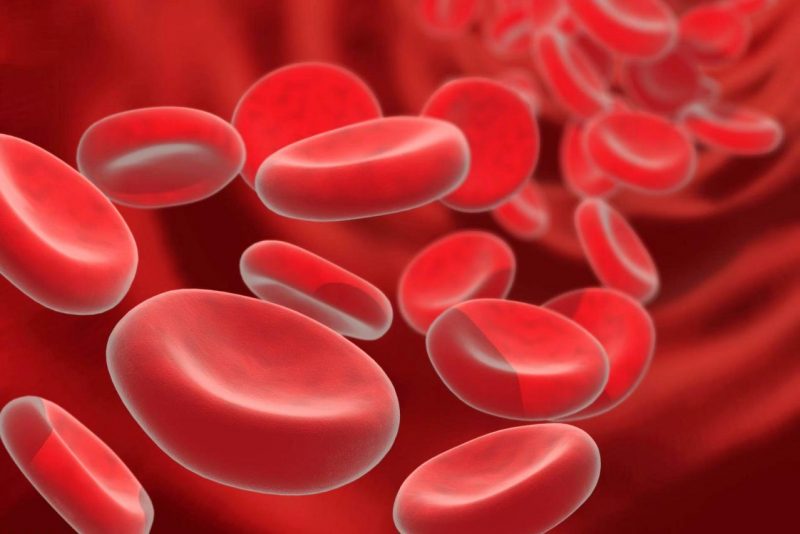The qualitative level of the blood composition is constantly changing over the course of life. A special table of hemoglobin norms in women by age will help prevent the appearance of pathological indicators in the analysis results.
Monitoring changes in the blood formula is one of the easiest and most affordable ways to prevent the development of many diseases of the female body.
Material Content:
What is hemoglobin?
Hemoglobin is an iron-containing blood pigment that is found in red blood cells and ensures the transport of oxygen to tissues. By structure, hemoglobin is classified as a complex protein, the core of which contains iron, which binds oxygen molecules. It is hemoglobin that stains blood in red.

After the transfer of oxygen to the tissues, hemoglobin attaches carbon dioxide and transfers it to the lungs. Thus, this blood particle should be regarded as an element that provides the basic transport functions of the blood - nutrition and respiration.
Changes in hemoglobin indicators indicate a violation of the oxygen-transporting function, which leads to the development of various diseases - anemia, renal failure, hypoxemia and ischemia.
Under the influence of chemicals, carbon monoxide and an increase in blood sugar, hemoglobin acquires pathological forms that can only be detected through analysis.
How to determine hemoglobin level
To find out the level of hemoglobin, laboratory tests of blood samples taken from a finger are used. During the procedure, the number of red blood cells and the presence of abnormal cells are determined.

Blood sampling is performed on an empty stomach and not earlier than 8 hours after the last meal.
The norm of hemoglobin in the blood of women by age: table
Due to the specifics of the body, the standard indicators of iron in the blood in women are lower than in men, but higher than in children, and is 112-150 g / l.
| Age | Norm indicators, g / l |
|---|---|
| 17-19 | 112-148 |
| 20-29 | 118-150 |
| 30-39 | 120-145 |
| 40-49 | 120-140 |
| 50-59 | 115-138 |
| 60-65 | 114-135 |
| More than 65 | 105-130 |
In special periods of life - during pregnancy or menstruation, the blood composition changes, but this is not considered a sign of deviations if the indicators of the tests correspond to the accepted norm.
The norm of hemoglobin after 30 years
Blood counts change with age. In women under the age of 30 years, the hemoglobin norm in the blood reaches the highest possible level. Whereas after overcoming the 30-year milestone, a gradual decline in indicators begins.
Read also: how to quickly raise hemoglobin at home
Norm after 40 years

The process of reducing hemoglobin is observed throughout the life of a woman. Therefore, after 40 years, the hemoglobin norm in women is already 5 g / l lower than in thirty-year-olds. Changes in the composition of the blood become especially noticeable closer to the age of 50, when the stage of menopause changes in the body begins in women.
Hemoglobin after 50 years
In women after 50 years, the level of hemoglobin, as a rule, falls below the established norm. This is due to the instability of the hormonal balance characteristic of menopause. A woman becomes more emotional, and her stress resistance decreases markedly, which affects the composition of the blood.
During menopause, in order to raise the hemoglobin level to normal, doctors recommend taking drugs that normalize the hormonal level, and adjust the diet, focusing on healthy vitamin and iron-containing foods.
The exception is products that suppress the absorption of iron:
- milk;
- chicken protein;
- bread, pasta, cereals;
- hard drinks, including coffee and tea.
In addition, water intake should be increased.
The norm of hemoglobin after 60 years
After 60 years, the female body is characterized by the completion of hormonal adjustment and a slowdown in metabolic processes. Since the need for nutrients is not as high as before, the level of iron in the body is gradually falling.

To normalize the composition of the blood, older people need to follow a special diet aimed at increasing iron-containing products in the daily diet.
Signs of low hemoglobin
A decrease in the amount of hemoglobin in plasma indicates a violation of metabolic processes and the development of anemia. Such conditions are considered pathological and require correction.
A decrease in the number of blood cells is accompanied by a deterioration in well-being.

Most often, pathological changes are indicated by:
- sleep disturbances, insomnia;
- pallor of the skin;
- dry mouth
- Dizziness
- arrhythmia;
- migraine;
- exfoliating nails;
- plentifully falling out, brittle and dry hair;
- fatigue;
- caries;
- dyspnea;
- dry lips and cracks in the corners of the mouth.
Often anemic processes are manifested by the loss of smell and taste, especially in pregnant women.
If deviations from the norm are insignificant, special medication is not required, it is enough to observe the regime of work and rest, ensure a good sleep and reconsider the attitude to food and bad habits.
It is interesting:low hemoglobin
Causes of Low Hemoglobin
Despite the fact that anemia is an independent disease, doctors tend to regard its appearance as a signal about the presence of other health problems.

Among the main causes of blood cell deficiency are:
- lack of B vitamins and iron products in the diet;
- bleeding, including ulcerative, menstrual, postpartum, postoperative, as well as donation;
- dysbiosis;
- infectious, autoimmune and hereditary diseases;
- the release of insulin in tumor processes in the pancreas;
- hypothyroidism;
- hepatitis;
- stress
- drug abuse.
In addition, a decrease in the number of red blood particles is characteristic of women following a diet for weight loss.
Low hemoglobin treatment
It is possible to improve the blood formula with low hemoglobin, thanks to an integrated approach to treatment. Along with drug treatment, it is necessary to change the diet and lifestyle.
Drug treatment involves the use of iron-containing preparations - Actiferrin capsules, Ferry syrup, as well as the combination of Ferrofolgamma and Irovit. The choice and prescription of drugs can only be carried out by the attending physician. The average course of taking medication is two weeks.

A therapeutic diet involves the introduction into the diet of products that increase the level of iron in the body, or improve its digestibility. All kinds of vegetables, as well as apples, apricots, pumpkin, seaweed, pomegranates, herbs, nuts and citruses deserve special attention.
The list of the most useful animal products includes all types of meat and seafood, liver, kidneys and chicken yolks.
In addition, the number of spices such as cinnamon, mint, thyme and anise should be increased in the daily menu.
Lifestyle changes require regular physical activity, a good night's rest, and rejection of bad habits.
High hemoglobin in women
An increase in hemoglobin levels is fraught with no less serious health consequences than its decrease. Excess iron in the body manifests itself in drowsiness, increased fatigue, difficulty urinating, the appearance of bright areas against the background of pale skin, enlarged liver, decreased vision, poor or lack of appetite, and age spots.

Such violations may indicate the development of:
- erythrocytosis;
- bone marrow pathologies;
- hypertension
- diabetes mellitus;
- intestinal obstruction;
- oncological diseases;
- cardiac pathologies;
- diseases of the respiratory system.
A temporary increase in red blood cell counts is possible after a blood transfusion. Also, a high level of red blood cells is inherent in people living in high mountains or working at heights - pilots, crane operators, climbers.
Among other non-specific causes of hemoglobin increase are smoking, dehydration due to diuretics, burns, old age.
Signs of a change in hemoglobin in the plasma in one direction or another often coincide. A full medical examination is necessary to determine the exact cause of the violation.
How to reduce hemoglobin in the blood?
To normalize the increased levels of red blood cells in the plasma, doctors recommend taking medications that thin the blood. The list of the most effective drugs includes Curantil, Acecardol, Cardiomagnyl, Wazonit. In addition, hepatoprotective drugs are used, as well as products containing zinc, calcium, phosphorus and manganese.
In particularly difficult situations, doctors can use erythrophoresis or gastrotomy to remove excess red blood cells.

Dietary food involves the use of products that suppress the absorption of iron - all types of dairy products, pasta and bakery products, cereals.
The rate of hemoglobin in the blood during pregnancy
Changes that occur in the body of the expectant mother are reflected at the hemoglobin level. First of all, the accumulation of fluid is typical for pregnancy, as a result of which physiological dilution of the blood and a decrease in the concentration of red blood cells occur.
The normal hemoglobin level in pregnant women is 110-155 g / l.
A pathological decrease in pregnancy rates is possible against a background of iron and folic acid deficiency.As the fetus grows, these substances are consumed first of all, and their gradually growing shortage leads to anemia.
Low levels of hemoglobin during pregnancy can negatively affect the development of the fetus, or provoke premature birth.
Hemoglobin level in women with menstruation
Even the most minor bleeding affects the level of iron in the body, reducing it and causing a feeling of drowsiness and weakness. This process is natural, because during menstruation the body loses a certain amount of blood, and its compensation occurs slowly.

Moreover, a delay in menstruation can provoke a slowdown in the maturation of red blood cells and, as a result, a drop in blood viscosity. As a result, with the onset of the menstrual period, blood loss increases, further reducing hemoglobin.
If the discharge is too small, this may be a sign of an increase in the level of iron in the blood and an increase in its viscosity. Similar symptoms are characteristic of a number of diseases of the cardiovascular system and diabetes.
The lack of iron in the blood, as well as its excess should not be ignored. The help of a doctor and medical examination is the only right way to find the causes of the pathology, and its elimination.












